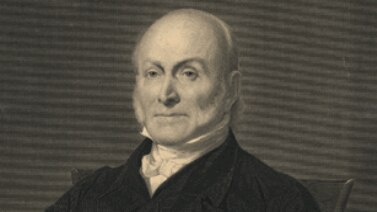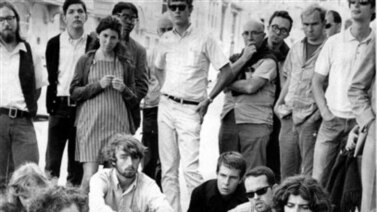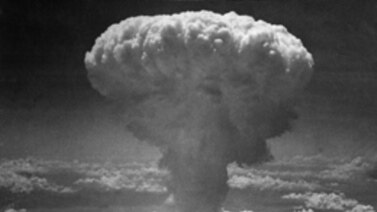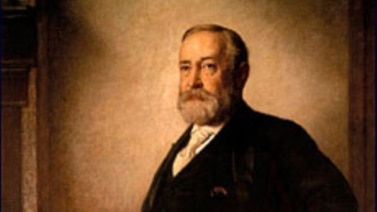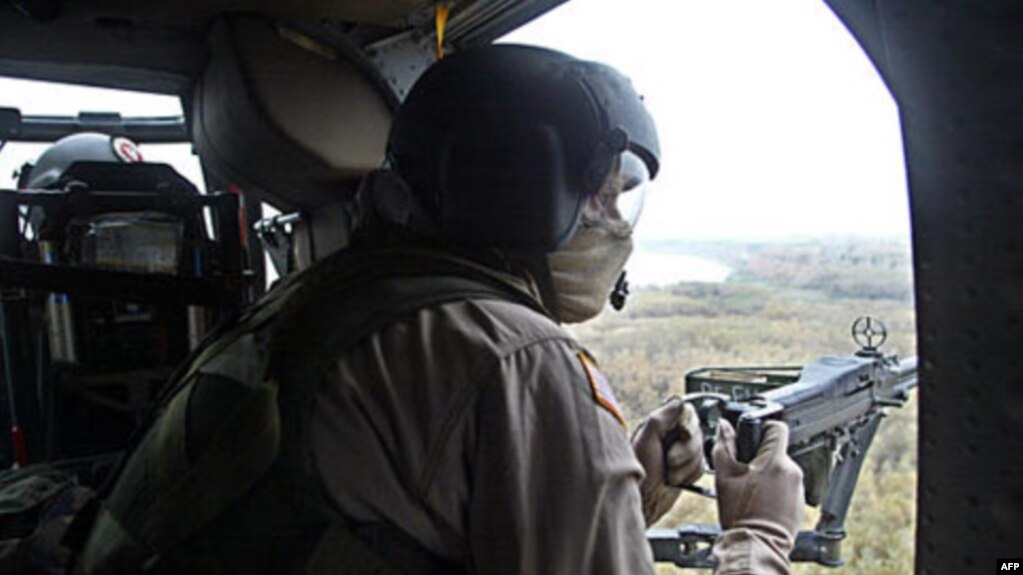
STEVE EMBER: Welcome to THE MAKING OF A NATION – American history in VOA Special English. I'm Steve Ember.
GEORGE W. BUSH: "Trusting in the sanity and restraint of Saddam Hussein is not a strategy, and it is not an option."[Applause]
(MUSIC)
This week in our series, we look at the American-led invasion of Iraq in March two thousand three. It was part of the “War on Terror” President George W. Bush had declared after the al-Qaida attacks on the United States on September eleventh, two thousand one.
In October of that year, the United States led the invasion of Afghanistan. The purpose was to attack al-Qaida and the Taliban rulers sheltering the group's leader, Osama bin Laden.
At the same time, Defense Secretary Donald Rumsfeld was proposing the possibility of military action against Iraq as well. American officials accused Iraq of supporting terrorism. They pointed out that Iraqi leader Saddam Hussein had used chemical weapons on his own people. They said there were signs that he was also trying to develop biological and nuclear weapons.
President Bush gave his annual State of the Union message to Congress in January two thousand two.
He described American successes in closing terrorist training camps in Afghanistan. He also spoke of cooperation from Pakistan toward the same goal in that country.
The president singled out three countries -- North Korea, Iran and Iraq -- as what he called an "axis of evil."
He said the United States would not wait to be attacked by terrorist groups or the nations that support them.
GEORGE W. BUSH: "Our second goal is to prevent regimes that sponsor terror from threatening America or our friends and allies with weapons of mass destruction. Some of these regimes have been pretty quiet since September the eleventh. But we know their true nature. North Korea is a regime arming with missiles and weapons of mass destruction, while starving its citizens.
"Iran aggressively pursues these weapons and exports terror, while an unelected few repress the Iranian people's hope for freedom.
"Iraq continues to flaunt its hostility toward America and to support terror. The Iraqi regime has plotted to develop anthrax, and nerve gas, and nuclear weapons for over a decade. This is a regime that has already used poison gas to murder thousands of its own citizens — leaving the bodies of mothers huddled over their dead children. This is a regime that agreed to international inspections — then kicked out the inspectors. This is a regime that has something to hide from the civilized world."
And President Bush had this warning:
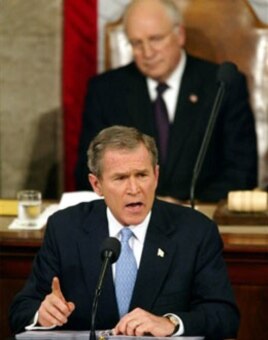
GEORGE W. BUSH: "States like these, and their terrorist allies, constitute an axis of evil, arming to threaten the peace of the world. By seeking weapons of mass destruction, these regimes pose a grave and growing danger. They could provide these arms to terrorists, giving them the means to match their hatred.”
President Bush said that the United States would not permit the world's most dangerous regimes to threaten U.S. security with the world's most destructive weapons.
(MUSIC)
Iraq had been defeated in nineteen ninety-one after it invaded Kuwait. The United Nations ordered Iraq to destroy all of its development efforts for nuclear, biological and chemical weapons. The U.N. had sent teams of weapons inspectors to make sure Iraq was following its resolutions. But since nineteen ninety-eight, Iraq had refused to let U.N. weapons inspection teams into the country.
President Bush and his administration argued that Iraq was making or hiding weapons of mass destruction, known as WMDs. He said if the United Nations failed to force Iraq to disarm, the United States might launch a military attack against the country.
In September two thousand two, a year after the attacks on New York and Washington, Bush addressed the U.N. General Assembly.
GEORGE W. BUSH: “We know that Saddam Hussein pursued weapons of mass murder even before inspectors were in his country. Are we to assume that he stopped when they left?”
With that speech he began making a case to the international community for an invasion of Iraq.
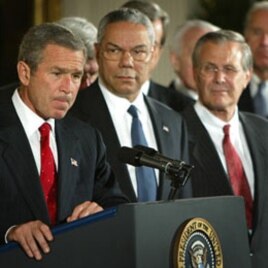
GEORGE W. BUSH: "The history, the logic, and the facts lead to one conclusion – Saddam Hussein’s regime is a grave and gathering danger. To suggest otherwise is to hope against the evidence. To assume this regime’s good faith is to bet the lives of millions and the peace of the world in a reckless gamble. And this is a risk we must not take.”
Back in Washington, the president asked Congress to pass a resolution giving him power to use military force against Iraq. Congress approved the resolution in October.
(MUSIC)
In November, Iraq agreed to permit U.N. weapons inspectors to return. After more inspections, the leader of the team reported back to the United Nations in February two thousand three. He said the team had found no evidence of weapons of mass destruction. But he also said Iraq was not cooperating with efforts to find out if suspected weapons had been destroyed and if weapons programs had ended.
DONALD RUMSFELD: “The United States knows that Iraq has weapons of mass destruction. Any country on the face of the earth that has an active intelligence program knows that Iraq has weapons of mass destruction.”
Donald Rumsfeld was not alone in supporting the idea of a war against Iraq.
DICK CHENEY: “There is no doubt that Saddam Hussein now has weapons of mass destruction ... "
Other supporters included Vice President Dick Cheney.
DICK CHENEY: “that he is amassing them to use against our friends, against our allies and against us.”
And "neocons," or members of the neoconservative movement.
In January of two thousand three, President Bush used his State of the Union speech to strengthen his case against Iraq.
GEORGE W. BUSH: “Year after year, Saddam Hussein has gone to elaborate lengths, spent enormous sums, taken great risks to build and keep weapons of mass destruction. But why? The only possible explanation, the only possible use he could have for those weapons, is to dominate, intimidate, or attack.”
He said British intelligence reported that Saddam Hussein had tried to buy uranium from Africa. Uranium can be used to make nuclear weapons. Several months later, the White House said the intelligence was false.
The president wanted the United Nations to approve military force against Iraq. Britain and Spain also supported military action. They asked the Security Council to pass a resolution approving military action against Iraq. But some of the countries on the fifteen-member Security Council were opposed. They included Germany, France and Russia. They said inspections should be increased and that the use of force should only be a last choice. The United States withdrew the resolution.
The United States and Britain decided on a plan to invade Iraq. There was strong support among Americans. But there was widespread international opposition. In February two thousand three, millions of people in hundreds of cities around the world took part in anti-war protests. Opponents argued that the United States would be violating international law by invading a nation that they said was not an immediate threat.
There was no evidence that Iraq was involved in the 9-11 attacks. But President Bush said he wanted to prevent Saddam Hussein from supplying weapons of mass destruction to terrorist groups that might attack the United States or other countries.
GEORGE W. BUSH: “Intelligence gathered by this and other governments leaves no doubt that the Iraq regime continues to possess and conceal some of the most lethal weapons ever devised. This regime has already used weapons of mass destruction against Iraq's neighbors and against Iraq's people.
“The regime has a history of reckless aggression in the Middle East. It has a deep hatred of America and our friends and it has aided, trained and harbored terrorists, including operatives of Al Qaeda.”
He also argued that the Iraqi leader was an evil dictator who had ordered the killing of thousands of people and should be removed from power.
(MUSIC)
Bush made his intentions clear in a televised speech on March seventeenth two thousand three.
GEORGE W. BUSH: “The United Nations Security Council has not lived up to its responsibilities, so we will rise to ours. In recent days, some governments in the Middle East have been doing their part. They have delivered public and private messages urging the dictator to leave Iraq, so that disarmament can proceed peacefully. He has thus far refused.”
And President Bush told Saddam Hussein and his sons to leave Iraq or face military action.
GEORGE W. BUSH: “All the decades of deceit and cruelty have now reached an end. Saddam Hussein and his sons must leave Iraq within 48 hours. Their refusal to do so will result in military conflict, commenced at a time of our choosing.”
The Iraqi leader rejected the demand. U.N. inspection teams had requested more time to complete their job. But they left Iraq four days before the American-led invasion began on March twentieth.
(SOUND: Invasion of Iraq)
GEORGE W. BUSH: “At this hour, American and coalition forces are in the early stages of military operations to disarm Iraq, to free its people, and to defend the world from grave danger.”
On March twentieth, Iraqi time, air strikes by the United States and Britain began what was called "Operation Iraqi Freedom." The United States said the war was meant to disarm Iraq of weapons of mass destruction, end Saddam Hussein's support for terrorism and free the Iraqi people. A number of other countries joined the war effort.
The coalition quickly defeated the Iraqi military. On April ninth, United States forces took control of Baghdad. Iraqis and American forces destroyed a large statue of Saddam Hussein in the capital.
The allies controlled all major Iraqi cities. Saddam Hussein had disappeared into hiding.
(SOUND: Bush's plane landing on carrier deck)
On May first, President Bush was flown to the aircraft carrier USS Abraham Lincoln to make an announcement.
GEORGE W. BUSH: "Thank you all very much. Admiral Kelly, Captain Card, officers and sailors of the USS Abraham Lincoln, my fellow Americans, major combat operations in Iraq have ended. In the battle of Iraq, the United States and our allies have prevailed."[Applause]
In the background there was a banner reading "Mission Accomplished."
(MUSIC)
The government in Baghdad had fallen. But a deepening conflict in Iraq lay ahead. American troops and an American inspection team searched Iraq for weapons of mass destruction. But none were found. The intelligence used to justify the invasion had turned out to be wrong. Intelligence failures happen. But some Americans felt that they had been misled by the administration in its push to go to war against Iraq.
(MUSIC)
The United States turned its attention to rebuilding Iraq and establishing a new Iraqi government. The Coalition Provisional Authority was created as a temporary government in Iraq. President Bush replaced a general with State Department official Paul Bremer as head of the authority.
People rioted and stole from government buildings, museums and banks. In many places there was little or no electric power, running water or trash collection.
The Coalition Provisional Authority dismissed the Iraqi army and the government. Those people now had no jobs.
The presence of foreigners in their country angered many Iraqis. Militants attacked coalition troops. They also attacked Iraqis and international organizations seen as cooperating with American forces. In some areas, longtime religious differences between Sunni and Shiite Muslims grew into armed disputes.
ROBERT RIGGS (EMBEDDED REPORTER): “Today marks the third day of our road march toward Baghdad."
The invasion of Iraq was the most closely reported war in military history. At the start of the war, as many as seven hundred reporters and photographers were embedded with the troops, living and traveling with them. Also, blogs gave people the ability to immediately read what troops were writing about the war from the front lines.
SOLDIER: “I’m just glad to be a part of something like this, that’s hopefully going to free a lot of people that are oppressed, and get a madman out of power, too.”

In December two thousand three, United States forces captured Saddam Hussein. He was hiding in a hole on a farm near Tikrit. He was later tried by Iraqis for crimes against his people and hanged. But that did not mean the war in Iraq would end anytime soon.
George Bush became a war president. He had two wars in lead as commander in chief, one in Afghanistan and the other in Iraq. But he also had matters of domestic policy to deal with as chief executive in Washington. That will be our story next week.
(MUSIC)
You can find our series online with transcripts, MP3s, podcasts and pictures at voaspecialenglish.com. You can also follow us on Facebook and Twitter at VOA Learning English. I'm Steve Ember, inviting you to join us again next week for THE MAKING OF A NATION -- American history in VOA Special English.
Contributing: Jerilyn Watson
This was program #236. For earlier programs, type "Making of a Nation" in quotation marks in the search box at the top of the page.
